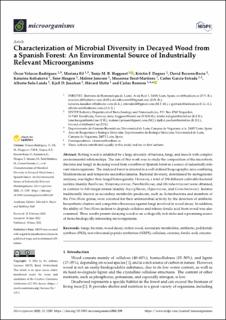| dc.contributor.author | Velasco-Rodríguez, Óscar | |
| dc.contributor.author | Fil, Mariana | |
| dc.contributor.author | Heggeset, Tonje Marita Bjerkan | |
| dc.contributor.author | Degnes, Kristin Fløgstad | |
| dc.contributor.author | Becerro-Recio, David | |
| dc.contributor.author | Kolsaková, Katarina | |
| dc.contributor.author | Haugen, Tone | |
| dc.contributor.author | Jønsson, Malene | |
| dc.contributor.author | Toral-Martínez, Macarena | |
| dc.contributor.author | García-Estrada, Carlos | |
| dc.contributor.author | Sola-Landa, Alberto | |
| dc.contributor.author | Josefsen, Kjell Domaas | |
| dc.contributor.author | Sletta, Håvard | |
| dc.contributor.author | Barreiro, Carlos | |
| dc.date.accessioned | 2022-08-08T07:35:12Z | |
| dc.date.available | 2022-08-08T07:35:12Z | |
| dc.date.created | 2022-06-22T08:18:18Z | |
| dc.date.issued | 2022 | |
| dc.identifier.citation | Microorganisms, 2022, 10, 6, 1-21. | en_US |
| dc.identifier.issn | 2076-2607 | |
| dc.identifier.uri | https://hdl.handle.net/11250/3010515 | |
| dc.description.abstract | Rotting wood is inhabited by a large diversity of bacteria, fungi, and insects with complex environmental relationships. The aim of this work was to study the composition of the microbiota (bacteria and fungi) in decaying wood from a northwest Spanish forest as a source of industrially relevant microorganisms. The analyzed forest is situated in a well-defined biogeographic area combining Mediterranean and temperate macrobioclimates. Bacterial diversity, determined by metagenome analyses, was higher than fungal heterogeneity. However, a total of 194 different cultivable bacterial isolates (mainly Bacillaceae, Streptomycetaceae, Paenibacillaceae, and Microbacteriaceae) were obtained, in contrast to 343 fungal strains (mainly Aspergillaceae, Hypocreaceae, and Coniochaetaceae). Isolates traditionally known as secondary metabolite producers, such as Actinobacteria and members of the Penicillium genus, were screened for their antimicrobial activity by the detection of antibiotic biosynthetic clusters and competitive bioassays against fungi involved in wood decay. In addition, the ability of Penicillium isolates to degrade cellulose and release ferulic acid from wood was also examined. These results present decaying wood as an ecologically rich niche and a promising source of biotechnologically interesting microorganisms. | en_US |
| dc.language.iso | eng | en_US |
| dc.publisher | MDPI | en_US |
| dc.rights | Navngivelse 4.0 Internasjonal | * |
| dc.rights.uri | http://creativecommons.org/licenses/by/4.0/deed.no | * |
| dc.subject | enzyme | en_US |
| dc.subject | ferulic acid | en_US |
| dc.subject | esterase | en_US |
| dc.subject | cellulase | en_US |
| dc.subject | non-ribosomal peptide synthetase (NRPS) | en_US |
| dc.subject | polyketide synthase (PKS) | en_US |
| dc.subject | antibiotic | en_US |
| dc.subject | secondary metabolites | en_US |
| dc.subject | rotten wood | en_US |
| dc.subject | wood decay | en_US |
| dc.subject | bacteria | en_US |
| dc.subject | fungi | en_US |
| dc.title | Characterization of Microbial Diversity in Decayed Wood from a Spanish Forest: An Environmental Source of Industrially Relevant Microorganisms | en_US |
| dc.title.alternative | Characterization of Microbial Diversity in Decayed Wood from a Spanish Forest: An Environmental Source of Industrially Relevant Microorganisms | en_US |
| dc.type | Peer reviewed | en_US |
| dc.type | Journal article | en_US |
| dc.description.version | publishedVersion | en_US |
| dc.rights.holder | Copyright: © 2022 by the authors. Licensee MDPI, Basel, Switzerland. This article is an open access article distributed under the terms and conditions of the Creative Commons Attribution (CC BY) license (https:// creativecommons.org/licenses/by/ 4.0/). | en_US |
| dc.subject.nsi | VDP::Bioteknologi: 590 | en_US |
| dc.subject.nsi | VDP::Biotechnology: 590 | en_US |
| dc.subject.nsi | VDP::Bioteknologi: 590 | en_US |
| dc.subject.nsi | VDP::Biotechnology: 590 | en_US |
| dc.source.pagenumber | 21 | en_US |
| dc.source.volume | 10 | en_US |
| dc.source.journal | Microorganisms | en_US |
| dc.source.issue | 6 | en_US |
| dc.identifier.doi | 10.3390/microorganisms10061249 | |
| dc.identifier.cristin | 2034074 | |
| dc.relation.project | Norges forskningsråd: 271062 | en_US |
| dc.source.articlenumber | 1249 | en_US |
| cristin.ispublished | true | |
| cristin.fulltext | original | |
| cristin.qualitycode | 1 | |

